Disclaimer: Some links in this article may be affiliate links. These links may earn us a small commission, but rest assured, our reviews are unbiased and not influenced by these affiliations. Your trust is our priority, and we are committed to providing honest assessments of the products we recommend.
Welcome to our comprehensive guide on everything you need to know about guitars. Whether you’re a beginner or an experienced player, this guide will cover all aspects of guitars including acoustic, electric, and bass guitars, guitar techniques, beginner tips, guitar practice, guitar care, maintenance tips, instrument upkeep, guitar vs ukulele, musical instruments comparison, guitar selection, buying guide, and finding the best guitar for you.

Table of Contents
Key Takeaways
- Acoustic, electric, and bass guitars are the three main types of guitars.
- Guitar techniques and beginner tips are crucial for improving your playing ability.
- Guitar care and maintenance tips ensure the longevity and optimal performance of your instrument.
- Choosing the right guitar involves considering factors such as budget, body type, and level of experience.
- Guitar accessories like cases, stands, and straps enhance your playing experience.
Introduction to Guitars
Guitars are versatile and timeless musical instruments that have been around for centuries. They come in different shapes, sizes, and styles, but the most common types are acoustic and electric guitars.
Acoustic guitars produce sound naturally and do not require any external amplification. They come in various sizes, from the small and portable parlor guitar to the large and booming jumbo guitar. When choosing the best acoustic guitar, consider factors like your skill level, budget, and style preferences.

On the other hand, electric guitars require amplifiers to produce sound. They have a sleek body design and produce a range of sounds, from mellow to gritty and everything in between. Electric guitars are a great choice if you want to play rock, metal, or blues.
If you are undecided between acoustic and electric guitars, consider the type of music you want to play, your budget, and your level of experience. Both types have their pros and cons, so it’s essential to assess your preferences before making a decision.
Types of Guitars
As a musician, choosing the right guitar can have a significant impact on your playing style and preferences. With so many guitars available on the market today, it can be tough to know where to start. That’s why it’s essential to understand the different types of guitars that are available before making any purchase.
In this section, we’ll explore various types of guitars, including acoustic, electric, and bass guitars. Regardless of your experience level, understanding the features and benefits of these guitar types can help you make a more informed decision when selecting your next instrument.
First, let’s take a closer look at acoustic guitars. These guitars are popular among musicians for their warm and natural tones. They produce sound by the vibration of the strings, which is then amplified by the guitar’s hollow body.

Within the acoustic guitar category, there are different subtypes, such as classical, steel-string, and folk guitars, all with a unique sound and playing style.
Next up, we have electric guitars. These guitars have a solid body and produce sound by converting string vibrations into electrical signals. They are popular among musicians playing rock, blues, and jazz and offer a broad range of tones and effects.

Finally, we have bass guitars, which are similar in appearance to electric guitars but designed to produce low-frequency sounds. They are essential in bands, providing the foundational rhythm and groove. Bass guitars can be played with fingers or with a pick and come in various styles, including electric and acoustic bass guitars.
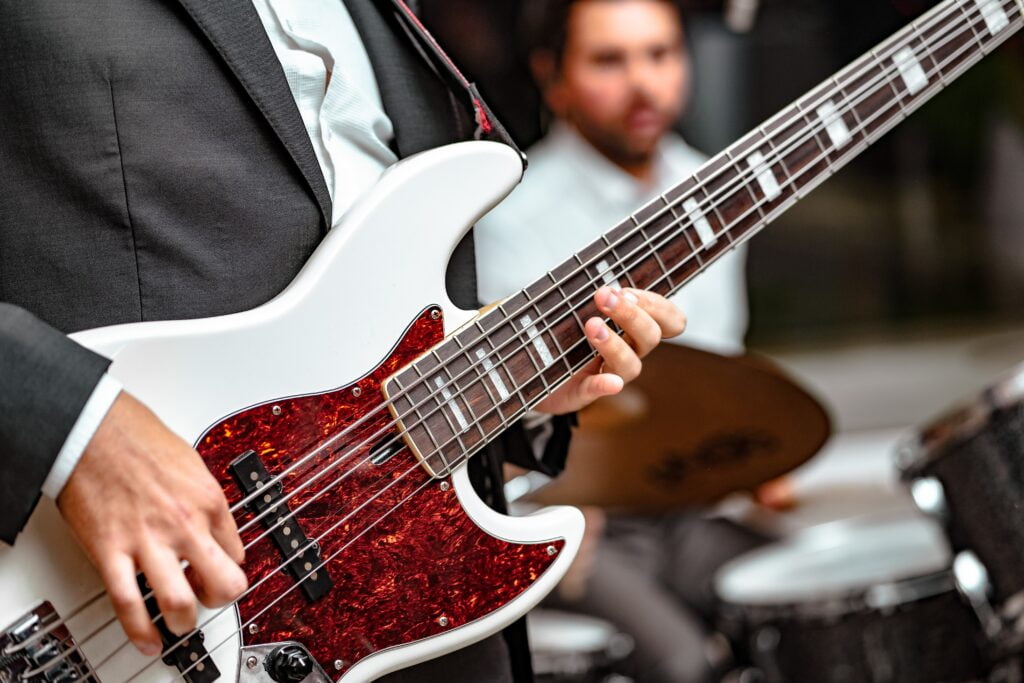
By now, you should have a better understanding of the different types of guitars available to you. In the next sections, we’ll dive deeper into acoustic, electric, and bass guitars to help you choose the best option for your playing style.
Acoustic Guitars
Acoustic guitars are one of the most recognizable and popular types of guitars. They are known for their warm and natural sound, which they produce through the vibration of the strings, amplified by the hollow body of the instrument. As a guitarist, understanding the different types of acoustic guitars can help you choose the right one for your playing style and preferences.

There are several subtypes of acoustic guitars, including:
- Classical guitars: These guitars have nylon strings and produce a mellow and soft sound. They are commonly used in classical music and can be played with either fingers or a plectrum.
- Steel-string acoustic guitars: These guitars have steel strings and produce a brighter, louder sound. They are popular for playing folk, country, and pop music.
- Folk guitars: These guitars are similar to steel-string acoustic guitars but have a smaller body and neck. They are ideal for fingerpicking and playing in a smaller setting.
Choosing the right acoustic guitar ultimately comes down to your personal preferences, playing style, and budget. Whether you’re a beginner or an experienced player, an acoustic guitar is a versatile and rewarding instrument to play.
Electric Guitars
Electric guitars are undoubtedly the most iconic and recognizable type of guitar. They have a solid body and use pickups to convert string vibrations into electrical signals. These signals are then amplified through an external amplifier, allowing the guitarist to adjust the volume and tone. Electric guitars are highly versatile and are used in a wide range of genres, including rock, pop, blues, and jazz.
When it comes to choosing an electric guitar, there are several factors to consider. First, think about the style of music you want to play. Different genres may require different types of guitars or pickups. Second, consider your skill level and budget. Electric guitars can range from affordable entry-level options to high-end, professional-grade instruments.
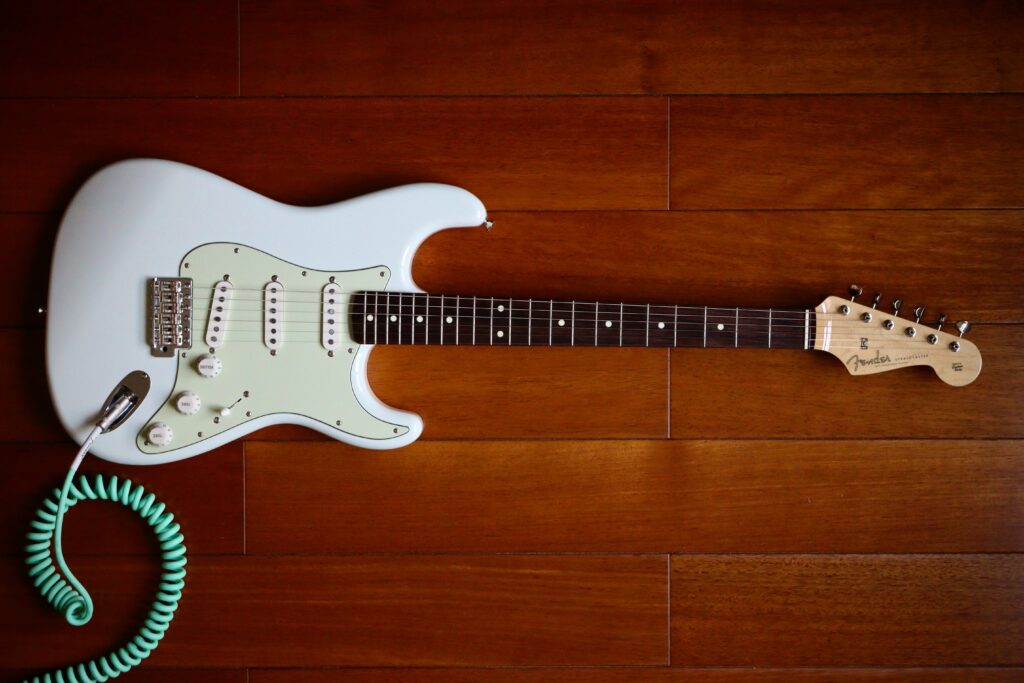
Some popular types of electric guitars include the Stratocaster, Les Paul, and Telecaster. Each type offers a unique sound and feel, so it’s a good idea to try different guitars to find the one that suits you best. It’s also worth noting that electric guitars can be played with a multitude of effects, such as distortion, reverb, and delay, to further enhance your sound.
Overall, electric guitars are an excellent choice for those looking for a versatile and expressive instrument. Whether you’re playing in a band or practicing solo, the electric guitar offers a wide range of tones and effects to explore.
Bass Guitars
When it comes to providing the foundational rhythm and groove of a band, there is no instrument quite like the bass guitar. These guitars are similar in appearance to electric guitars but are designed specifically to produce low-frequency sounds.
Bass guitars can be played with fingers or with a pick, depending on the player’s preference. They come in various styles, including electric bass guitars and acoustic bass guitars. Electric bass guitars are more commonly used in bands, as they can be amplified easily and offer a wide range of tones.
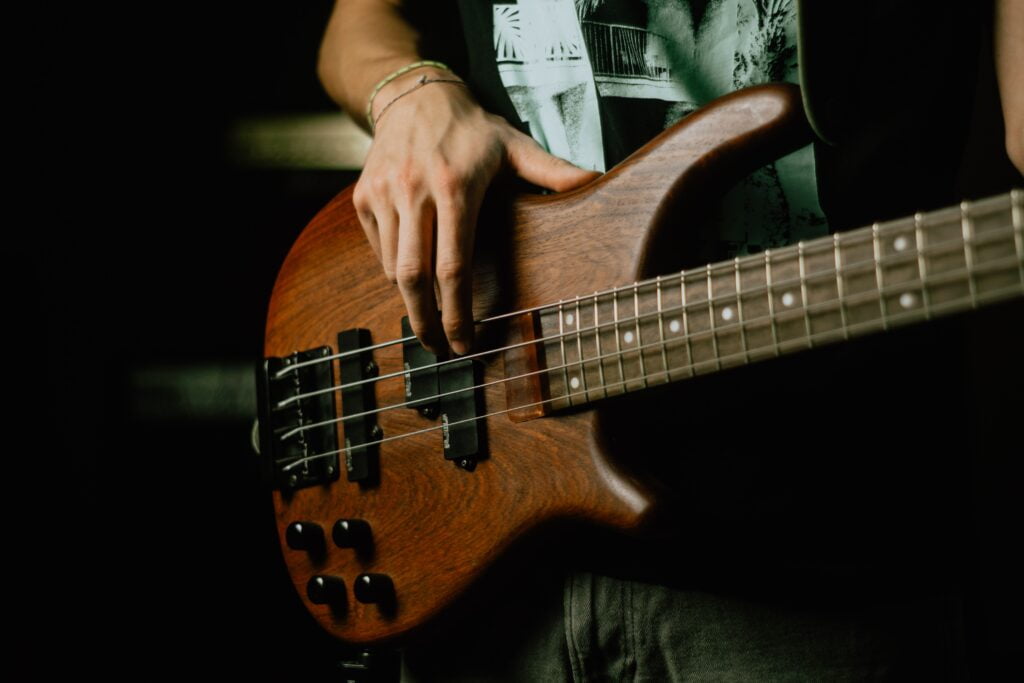
Acoustic bass guitars, on the other hand, produce sound through the vibration of the strings, similar to acoustic guitars. They are well-suited for smaller, more intimate performances.
Whether you’re a beginner or an experienced player, there is a bass guitar out there to suit your playing style and preferences. So if you’re looking to provide the backbone of a band’s rhythm section, consider investing in a bass guitar.
Overall, bass guitars are an important part of the music world and have their own unique place among the various types of guitars. So whether you’re a guitarist or not, take some time to appreciate the foundational role that bass guitars play in music.
Types of Guitar Strings
Guitar strings come in different materials and gauges, giving players a variety of options to choose from. The two most common materials used for guitar strings are steel and nylon.
Steel strings are commonly used for acoustic and electric guitars and come in light, medium, and heavy gauges. Lighter strings are more comfortable to play but may sacrifice volume and projection, while heavier strings produce a more robust tone but require more finger strength.
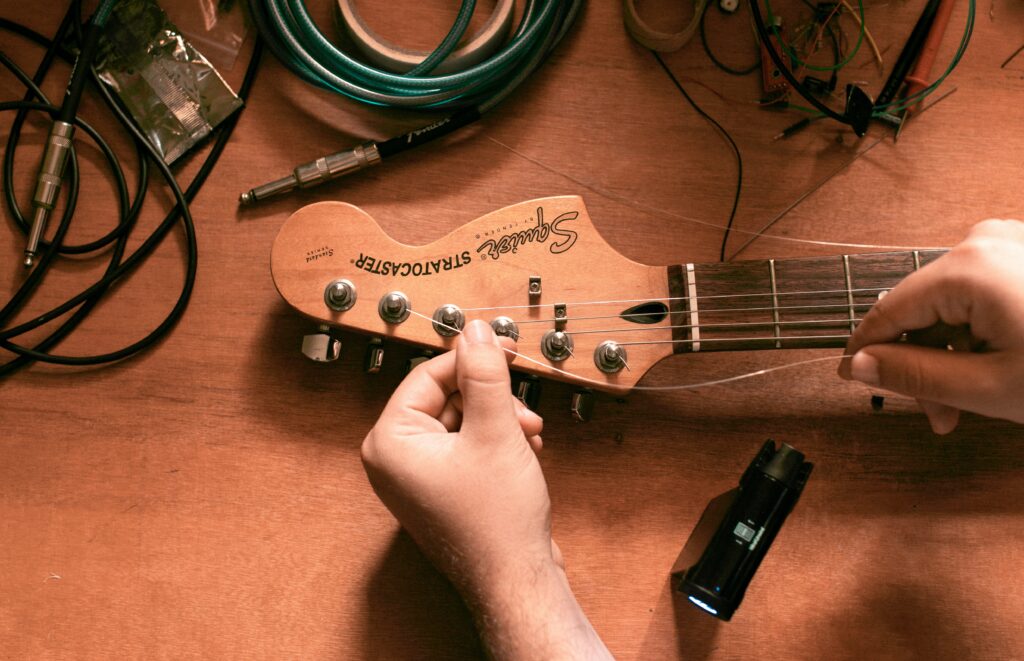
Nylon strings are typically used for classical guitars and produce a warmer and mellow sound. They are easier on the fingers than steel strings and come in different tensions, from high to low.
When selecting guitar strings, consider your playing style, guitar type, and tone preferences. Experiment with different gauges and materials to find the perfect fit for you.
Guitar Selection Guide
Choosing the perfect guitar can be daunting, but we’re here to help. Whether you’re a beginner or an experienced guitarist, there are a few factors to consider when searching for the right instrument. In this buying guide, we’ll provide you with all the necessary information to make an informed decision.
Acoustic vs Electric
When deciding which type of guitar to buy, it’s essential to consider the sound you want to create. Acoustic guitars produce a more natural sound and are ideal for playing folk, country, and rock music. In contrast, electric guitars allow you to explore various genres, including jazz, blues, and metal.

Another factor to consider is the cost. Acoustic guitars are often less expensive than electric guitars, but electric guitars require additional equipment such as an amplifier to create sound.
Factors to Consider
Before making your purchase, it’s essential to determine your budget, skill level, and the purpose of the guitar.
If you’re a beginner, it’s best to start with a basic guitar that suits your needs and budget. As you progress, you can upgrade to a more advanced guitar.
Some guitarists prefer to play a specific musical style, so it’s essential to choose a guitar that suits that particular genre. For example, if you enjoy playing classical music, a nylon-stringed guitar is ideal for achieving that sound.
Your body size and the guitar’s size are also crucial factors to consider. A guitar that’s too big or too small can affect your comfort and playing ability.
Types of Guitars
| Guitar Type | Description |
|---|---|
| Acoustic Guitars | Produce sound through vibration from the strings, creating natural and warm tones. |
| Electric Guitars | Require an amplifier to produce sound, allowing for versatility in musical genres. |
| Bass Guitars | Designed for playing basslines and rhythm section, produce a deep and low sound. |
See More
- Buying a Guitar Online in India: A Simplified Buyer’s Guide
- Best Guitar Under 5000 Rupees
- Best Guitar Under 7000 Rupees
Guitar vs Ukulele: A Comparison
If you are torn between a guitar and a ukulele, you are not alone. Both instruments have their unique characteristics and appeal to different types of musicians. In this section, we will compare the guitar and ukulele to help you make an informed decision.
Guitar
The guitar is a versatile instrument that is commonly used in various genres of music. It has a larger body, longer neck, and six strings, which are often made of steel or nylon. The guitar’s sound is produced by plucking or strumming the strings with a pick or fingers, and it can be amplified using an amp.
Guitars offer a wide range of notes and chords, making them suitable for solo and accompaniment playing. They are available in different types, including acoustic and electric, and are often used in rock, pop, country, and classical music.

Ukulele
The ukulele is a small, four-stringed instrument that originated in Hawaii. It has a compact body and a shorter neck, and the strings are usually made of nylon. The ukulele’s sound is produced by plucking or strumming the strings with fingers or a felt pick.
Ukuleles have a unique, bright tone and are often used in folk, Hawaiian, and indie music. They are relatively easy to play and are a popular choice for beginners.
Check out our comprehensive guide about ukuleles

Comparison
| Guitar | Ukulele |
|---|---|
| Has a larger body and longer neck | Has a compact body and shorter neck |
| Has six strings | Has four strings |
| Strings are often made of steel or nylon | Strings are usually made of nylon |
| Produces a wide range of notes and chords | Produces a unique, bright tone |
| Often used in rock, pop, country, and classical music | Often used in folk, Hawaiian, and indie music |
| May require more finger strength and coordination to play | Relatively easy to play and a popular choice for beginners |
In conclusion, choosing between a guitar and ukulele depends on your personal preferences and musical goals. If you prefer a wider range of notes and chords and are interested in playing various genres of music, the guitar may be a better choice for you. On the other hand, if you are looking for a compact and easy-to-play instrument with a unique sound, the ukulele may be right up your alley. Ultimately, the choice is yours, and we hope this comparison has helped you make an informed decision.
Left-Handed Guitars: Tips and Considerations
If you’re a left-handed guitarist, you might be struggling to find the perfect guitar. Many guitarists simply flip a right-handed guitar over and play it upside down, but this can be uncomfortable and challenging. In this section, we’ll discuss some tips and considerations for left-handed guitarists and guide you on how to buy a suitable guitar.
Tip 1: Consider buying a left-handed guitar
The most obvious solution for a left-handed guitarist is to buy a left-handed guitar. A left-handed guitar is designed for left-handed players, so the strings and other components will be flipped, making it easier to play. However, left-handed guitars can be more expensive and harder to find than right-handed ones. You might need to do some research to find the perfect one for you.
Tip 2: Test the guitar before you buy
When you’re buying a guitar, it’s essential to test it out to see if it feels comfortable and is suitable for your playing style. This is especially important for left-handed guitarists, as not all guitars will feel right. Visit a guitar store and try out some left-handed guitars to see which one suits you best.
Tip 3: Adjust the guitar to suit you
If you’re unable to find a left-handed guitar that feels right, you can always adjust the guitar to fit your needs. This might involve flipping the nut and bridge so that the strings are flipped, or switching the guitar strings around. You can also adjust the guitar strap so that it is larger on one side to accommodate a left-handed player. However, these adjustments should only be made by a professional guitar technician to ensure the guitar remains playable.

| Pros | Cons |
|---|---|
| Left-handed guitars are specifically designed for left-handed players, making it easier to play | Left-handed guitars can be more expensive and harder to find than right-handed ones |
| You can test out the guitar before you buy to see if it feels comfortable and is suitable for your playing style | Not all guitars will feel right, so you might need to adjust the guitar to fit your needs, which should only be done by a professional guitar technician |
If you’re a left-handed guitarist, don’t give up on finding the perfect guitar. With some research and adjustments, you can find or create a guitar that feels comfortable and suits your playing style. Keep in mind that there’s no right or wrong way to play the guitar, so follow your instincts and enjoy the journey!
Guitar Size Guide: Finding the Perfect Fit
When it comes to playing the guitar, finding the right size is crucial for comfort and playability. We understand that it can be challenging to determine the ideal size, especially if you’re a beginner. In this guitar size guide, we will provide a comprehensive overview to help you find the perfect fit for your body type and preferences.
The first step is to determine which type of guitar you want to play. Acoustic guitars are typically larger and have a more significant body depth, while electric guitars are generally smaller and more streamlined. Once you have made your choice, it’s time to consider the following factors:
| Factor | Considerations |
|---|---|
| Age | If you’re buying a guitar for a child, opt for a smaller size like a half or three-quarter size. For adults, a full-size guitar is usually the best choice. |
| Body type | Taller individuals may find dreadnought-sized guitars more comfortable, while smaller individuals may prefer a concert or parlor-sized guitar. |
| Playing style | If you’re into fingerpicking, a smaller guitar may be easier to handle. If you prefer strumming, a larger-bodied guitar may produce a fuller sound. |

It’s also essential to consider the scale length, which is the distance between the nut and the bridge. A shorter scale length may be more comfortable for those with smaller hands or shorter arms, while a longer scale length may provide better intonation and tone.
When selecting a guitar, we recommend visiting a music store to try out different sizes and styles. Play the guitar sitting down and standing up to ensure maximum comfort and adjustability. Look for a guitar that feels natural and is easy to handle.
Finally, remember that a guitar’s size affects its sound, so choose a size that complements your playing style and desired sound. Whether you’re a beginner or an experienced player, finding the right-sized guitar is essential for an enjoyable playing experience.
Guitar Brands: Which Ones to Consider
As you consider which guitar to buy, it can be overwhelming to navigate through the different brands available. That’s why we have compiled a list of reputable guitar brands to help you make an informed decision.
| Brand | Features | Price Range |
|---|---|---|
| Gibson | Known for producing high-quality electric guitars used by legendary guitarists like Jimmy Page and B.B. King. | Expensive |
| Epiphone | Epiphone guitars are renowned for their affordable quality and are a subsidiary of Gibson, offering a wide range of instruments for players of all levels. | Mid-range |
| Fender | A popular brand that produces both electric and acoustic guitars. Fender is known for its Stratocaster and Telecaster models. | Varies (affordable to expensive) |
| Ibanez | Ibanez guitars are celebrated for their versatile designs and are favored by musicians across genres for their craftsmanship and playability. | Varies (affordable to expensive) |
| Jackson | Jackson guitars are known for their iconic sleek designs and are a top choice for metal and rock guitarists seeking speed and precision. | Affordable to mid-range |
| Yamaha | A versatile brand that offers guitars suitable for beginners and professionals alike. Yamaha’s guitars are known for their affordability and durability. | Affordable to mid-range |
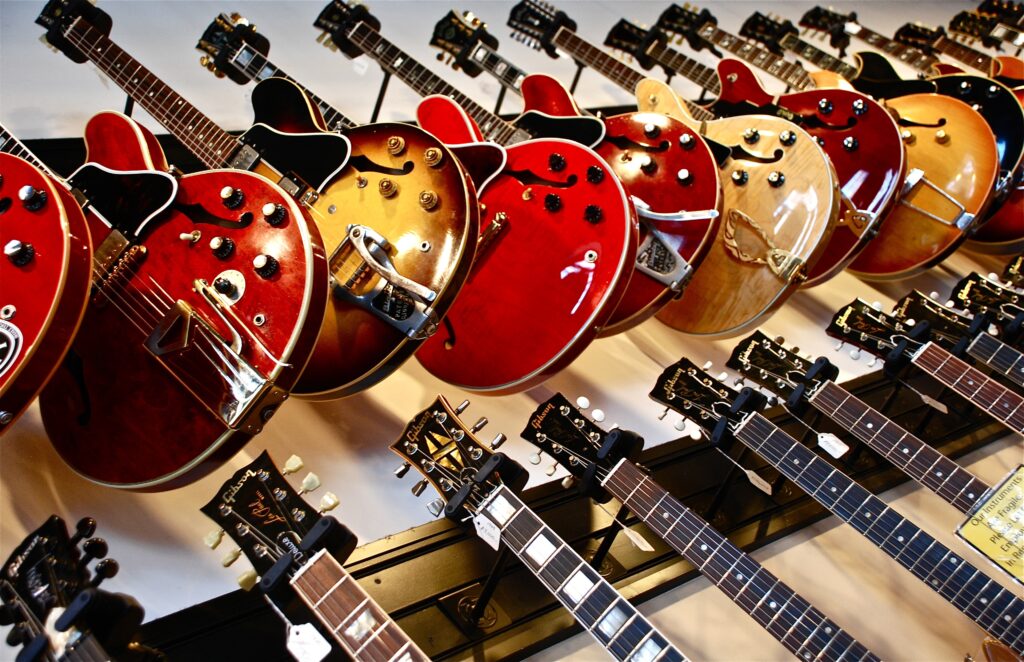
When selecting a guitar, it is crucial to consider your budget, skill level, and preferred style of music. Whether you are a beginner or a professional, there is a guitar brand suitable for you. Do your research, read reviews, and try out different guitars to find the perfect one for you.
Comparison: Ibanez MD39C vs. Yamaha F280
Getting Started: Beginner Guitar Tips
Are you new to playing guitar? We understand that starting a musical instrument can be overwhelming, but don’t worry, we have got you covered. Here are some valuable beginner guitar tips to help you begin your journey:
- Practice regularly: Practice makes perfect, and playing guitar is no exception. Set aside a regular time to practice every day, and stick to it. Even if it’s just 15 minutes a day, consistent practice will help you improve.
- Start slow: It is essential to take things slowly when you begin playing the guitar. Don’t rush into playing difficult pieces right away. Instead, start with simple chords and songs and gradually build up to more complex pieces.
- Focus on technique: Proper technique is crucial when playing the guitar. Take the time to learn the correct finger placement and hand positioning. This will help you play more accurately and prevent injuries.
- Use a metronome: A metronome is a tool that helps you keep time. It is an essential tool for beginner guitarists, as it helps you develop a sense of rhythm and timing.
- Learn from others: There is a wealth of resources available for guitarists, including online tutorials and lessons. Take advantage of these resources to improve your skills and learn new techniques.
- Stay motivated: Learning to play the guitar is a journey, and it can take time to see progress. Stay motivated by setting goals, tracking your progress, and celebrating small wins along the way.

By following these beginner guitar tips and practicing regularly, you’ll be on your way to becoming a proficient guitarist in no time.
Remember, playing guitar is a journey and not a destination. Enjoy the process and have fun!
Essential Guitar Accessories
As guitar enthusiasts, we know that owning a guitar is just the beginning of a journey. To enhance your playing experience, you must invest in essential guitar accessories. From stands to cases and straps, these accessories not only protect your instrument but also make it easier to handle and play.
Let’s take a closer look at some of the essential guitar accessories:
Guitar Cases
Guitar cases are essential for protecting your instrument from damage while transporting it. Soft gig bags are suitable for short trips, while hard-shell cases provide more protection for long journeys. When choosing a case, ensure that it fits your guitar snugly.
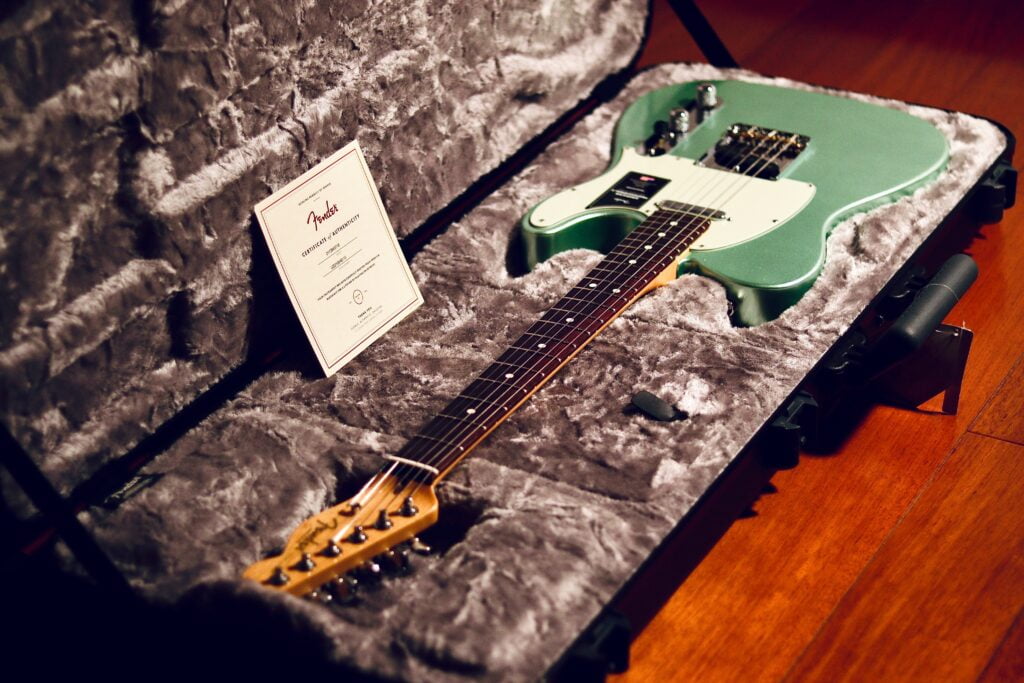
Guitar Stands
Guitar stands are useful for keeping your guitar within reach and accessible whenever you want to play it. They prevent your guitar from getting damaged as they keep it off the ground. Stands come in different forms, including wall-mounted, floor-stands and tripod stands. Choose one that meets your needs and fits your budget.

Guitar Straps
Guitar straps are essential for playing your guitar comfortably while standing. They come in different materials, including leather, nylon and cotton. Ensure that you choose a strap that is strong and adjustable, with comfortable padding for your shoulder.
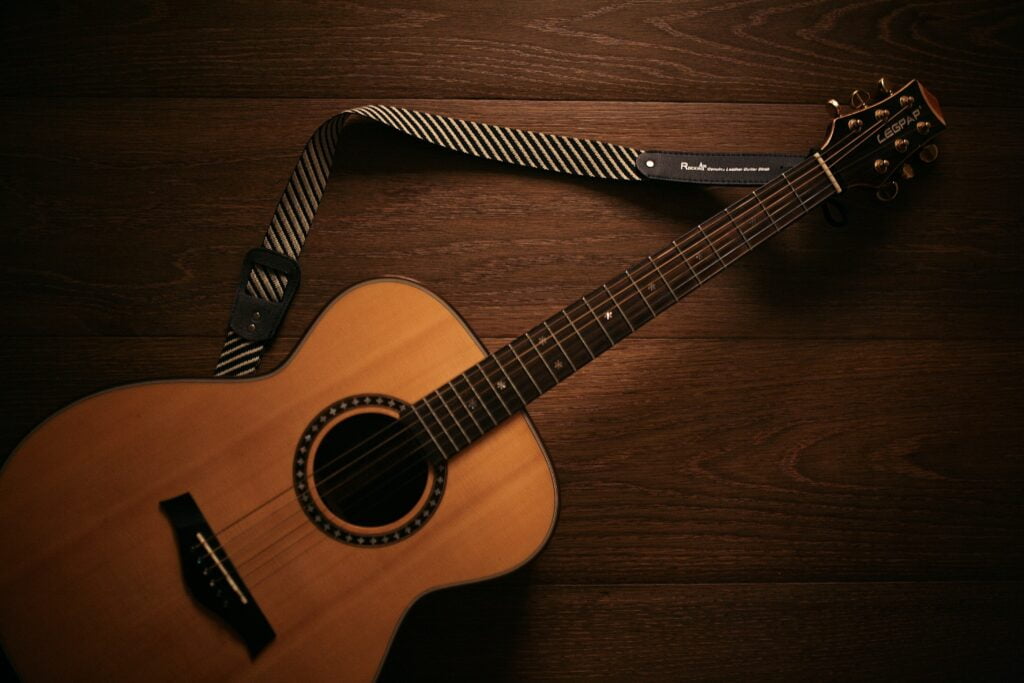
Other accessories that you may consider include guitar tuners, picks, capos, and cables. These accessories enhance your playing experience and make it easier to maintain your instrument.
Investing in essential guitar accessories is just as important as buying a guitar. These accessories protect your instrument from damage, make it easier to play, and enhance your overall guitar experience.
Guitar Maintenance Tips
As guitar enthusiasts, we understand the importance of maintaining our instruments. Regular maintenance not only ensures your guitar’s longevity but also enhances its sound quality and playability. In this section, we will provide valuable tips for guitar maintenance, including instrument upkeep, guitar care, cleaning advice, and tuning tips. So, let’s get started!
Note: Before starting any maintenance routine, make sure you have the appropriate tools and equipment, including a soft cloth, guitar polish, string cleaner, and a guitar tuner.
Instrument Upkeep
Proper instrument upkeep is essential for maintaining your guitar’s optimal performance. Here are some tips to keep in mind:
| Tips | Details |
|---|---|
| Store your guitar properly | Store your guitar in a dry place, away from direct sunlight and extreme temperatures. Use a guitar case to protect it during transport. |
| Keep your guitar in tune | Regularly tune your guitar using a tuner or tuning app. This will ensure that your guitar sounds great and avoids string stress. |
| Check for loose parts | Check the connections, nuts, and bolts on your guitar. Tighten any loose parts, and replace any that are missing. |
Guitar Care
Proper guitar care ensures that your guitar looks and sounds great. Here are some tips to keep in mind:
| Tips | Details |
|---|---|
| Clean your guitar regularly | Use a soft cloth to wipe down your guitar after each use to remove sweat, dirt, and fingerprints. Use guitar polish to keep your guitar looking new. |
| Change your strings | Change your guitar strings every two to three months or as needed. |
| Avoid extreme temperatures and humidity | Avoid exposing your guitar to extreme temperatures and humidity as they can damage your guitar’s finish and wood quality. |
Guitar Cleaning
Cleaning your guitar not only keeps it looking new but also ensures it sounds great. Here are some tips to follow:
| Tips | Details |
|---|---|
| Clean your guitar strings | Use a string cleaner to remove dirt and oil from your strings, improving their sound quality. |
| Clean the fretboard | Use lemon oil or a fretboard conditioner to clean and condition the fretboard. This will improve its playability and lifespan. |
| Clean the body and finish | Use a soft cloth to dust off the body, and use guitar polish to clean the finish. |
Guitar Tuning Tips
Keeping your guitar in tune is essential for optimal sound quality. Here are some tips to ensure that your guitar stays in tune:
| Tips | Details |
|---|---|
| Tune your guitar before each use | Make tuning your guitar part of your pre-play routine. Use a tuner or tuning app to ensure that your guitar is perfectly tuned before each use. |
| Stretch your strings | Stretch your strings before tuning them to ensure they settle properly and stay in tune. |
| Tune your guitar to the correct pitch | Use a reference pitch to ensure that your guitar is in tune with other instruments. |

Also See: Beginner’s guide to Guitar Tuning
By following these guitar maintenance tips, you can ensure that your guitar remains in top condition and lasts for years to come. Happy playing!
Electric Guitar Maintenance
If you are an electric guitar enthusiast, this section is for you. Electric guitars have their unique characteristics and maintenance requirements, which differ from acoustic and bass guitars. Here are our tips for taking care of your electric guitar:
- Guitar Cleaning: Keeping your electric guitar clean is essential. Use a soft cloth to wipe down the body and neck, and avoid using water or harsh chemicals. To clean the fretboard, use a specialized cleaner and a soft-bristled brush.
- Guitar Tuning Tips: Electric guitars require frequent tuning due to the nature of their design. Use a digital tuner to ensure accurate tuning, and check tuning before each session. You can also consider using locking tuners, which help keep strings in tune for longer.
- Bridge Maintenance: The bridge is a crucial component of an electric guitar, and it’s essential to keep it in good condition. Use a specialized cleaner to remove dirt and grime, and check the intonation regularly. If you notice any issues with the bridge, take it to a professional for repair.

By following these electric guitar care tips, you can keep your instrument in optimal condition and enjoy playing it for years to come.
Conclusion
We hope this guide has provided you with a comprehensive understanding of guitars – from the different types like acoustic, electric, and bass guitars to various guitar techniques and beginner tips. We have also offered advice on guitar care and maintenance, helped you choose between a guitar and a ukulele, and provided a buying guide to find the best guitar for you.
Whether you’re a seasoned player or just starting out, we believe this guide has equipped you with valuable insights into the guitar journey. No matter your preference – be it acoustic, electric, or bass guitars – we hope you feel confident in your ability to choose, play, and care for your instrument.
Remember, the guitar is not just a musical instrument – it’s a way to express your creativity, tell your stories, and connect with others through the power of music. So, pick up that guitar and let the music flow!

Frequently Asked Questions
What are the different types of guitars?
The different types of guitars include acoustic, electric, and bass guitars.
What are some beginner guitar tips?
Some beginner guitar tips include practicing regularly and using proper guitar practice techniques.
What should I consider when selecting a guitar?
When selecting a guitar, you should consider factors such as your budget, the type of guitar (acoustic or electric), and your skill level.
What is the difference between a guitar and a ukulele?
Guitars and ukuleles are different stringed instruments with distinct sounds and playing techniques. Guitars have six strings, while ukuleles typically have four strings.
Are there left-handed guitars available?
Yes, there are left-handed guitars available for left-handed guitarists. You can find guitars specifically designed for left-handed players.
What size guitar should I get?
The size of the guitar should be determined by your body type and personal preferences. A guitar size guide can help you find the perfect fit.
Which guitar brands should I consider?
Some reputable guitar brands to consider include Fender, Gibson, Taylor, and Martin. These brands offer quality instruments with a range of features and qualities.
What are some essential guitar accessories?
Some essential guitar accessories include cases, stands, and straps. These accessories enhance your playing experience and help protect your instrument.
How do I maintain my guitar?
Guitar maintenance includes regular cleaning, proper storage, and regular tuning. You can find valuable maintenance tips to keep your guitar in optimal condition.
What should I know about electric guitars?
Electric guitars have specific maintenance requirements, including tuning tips and cleaning advice tailored to electric models. Understanding these aspects will help you care for your electric guitar properly.
Disclaimer: Some links in this article may be affiliate links. These links may earn us a small commission, but rest assured, our reviews are unbiased and not influenced by these affiliations. Your trust is our priority, and we are committed to providing honest assessments of the products we recommend.